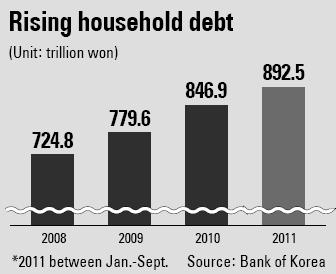Debt interest reaches new level

Experts expressed concern that the rising debt burden may result in downsizing consumer spending and end up curbing the nation’s growth.
According to the Bank of Korea and the local financial market, the household debt interest payment this year is believed to reach 56.2 trillion won ($48.3 billion) by the end of this year. Not only is the debt interest at a record high, it’s equal to 5 percent of last year’s 1,173 trillion won gross national income.
The rising interest burden comes with news of continuing growth of the nation’s household debt. Including mortgage loans and credit loans, household debt is edging close to 900 trillion won. The central bank earlier this month announced that although in the third quarter the household debt growth rate has decelerated, it still grew to 892.5 trillion won.
“Considering that the household debt has been growing at an average of 8 to 9 percent every quarter, it is possible that household debt may break the 900 trillion won level soon,” said a BOK official.
More alarming was that the lenders ability to repay debt has been falling. Last year, an average household income grew roughly 6 percent from 37.7 million won to 40 million won. However the average household debt grew 14.1 percent from 31.5 million won to 35.9 million won.
On top of rising household debt, the interest rate is adding an additional burden on borrowers. Last year on average the loan interest from banks was 5.35 percent. At the end of September the average interest edged closer to 6 percent at 5.86 percent.
The loan interest at savings banks is higher as it grew 4 percentage points from 12.7 percent at the end of last year to 16.7 percent at the end of September.
Particularly while mortgage loans in the third quarter eased, borrowing on credits and loans taken out from non-banking financial institutions such as insurance companies increased.
“A larger borrowing from non-banking financial institutions indicates that people are diverting to other sources for lending as borrowing from commercial banks has become difficult,” said a BOK official. “Additionally, this indicates that people with either low credit ratings or who come from low-income families are taking out loans not to purchase houses but rather to buy daily supplies.”
Many market observers projected that the central bank may likely freeze the nation’s key borrowing rate at the current level until early next year as global economic uncertainties, particularly from Europe, remain a threat to the global economy.
By Lee Ho-jeong [ojlee82@joongang.co.kr]










with the Korea JoongAng Daily
To write comments, please log in to one of the accounts.
Standards Board Policy (0/250자)